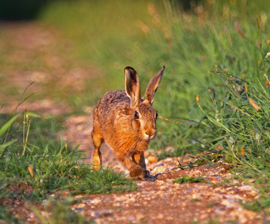-

Brown hares have suffered a serious population decline in the last century. Andy Fisher/www.andyfisherphotography.co.uk
Brown and mountain hares in the UK have suffered serious population declines in the last century, and although the government set a target to double brown hare numbers, these much-maligned animals continue to suffer from many threats.
It is believed that there were approximately 4 million brown hares in England in 1880.
Two research studies carried out in the 1990s revealed figures of just 817,500 (National Hare Survey 1991-1993) and 732,000 (1997-1999). [1]
Brown and mountain hares are listed on the UK Biodiversity Action Plan (UKBAP) [2], and mountain hares are also listed as a “species of community interest,” whose taking in the wild and exploitation may be subject to management measures, under Annex V of the EC Habitats Directive (1992) [3].
UK Biodiversity Action Plan
In 1995, the brown hare was included on the UKBAP “Short List of Globally Threatened/Declining Species” along with eight other mammals, including the water vole, European otter, dormouse and red squirrel. These species were recognised as having declined by “25 to 49 percent in numbers/range in Great Britain in last 25 years” [2]. A Species Action Plan (SAP) was created for brown hares, and a target set to double the 1995 spring numbers by 2010.
The SAP cited a loss of habitat and changes in agricultural methods as the main factors leading to the decline. It also recognised the role of legislation as a means of protecting species under pressure through exploitation, and the proposed a review of the use of legislation pertaining to the shooting and selling of hares in light of research findings on the seasonality of their reproduction. [4]
Failure to meet target
On 7 June 2011, DEFRA minister Richard Benyon confirmed that the Species Action Plan for the brown hare had failed to achieve its 2010 target. In reply to a parliamentary question asked by MP Neil Parish , he said: “…the data we have show that the population of brown hares in Great Britain has continued to increase since the 1980s, although not at the rate needed to meet the target in the UKBAP” [5].
There can be no doubt that brown hares have suffered a substantial decline in numbers and the failure to meet the 2010 SAP target illustrates that action to protect these vulnerable animals is urgently needed.
1. Hutchings, M & Harris, S (1996), National Hare Survey 1991-1993.
2. UK BAP priority terrestrial mammal species. http://jncc.defra.gov.uk/page-5170
3. EC Habitats Directive (1992), species assessments. http://jncc.defra.gov.uk/page-4063
4. Biodiversity: The UK Steering Group Report Volume 2: Action Plans (Annex F and Annex G), 1995. JNCC. http://webarchive.nationalarchives.gov.uk/20110303145213/http://ukbap.org.uk/UKPlans.aspx?ID=410#3
5. Hansard, Column 66W, 7 June 2011. http://www.publications.parliament.uk/pa/cm201011/cmhansrd/cm110607/text/110607w0003.htm#11060814001162
